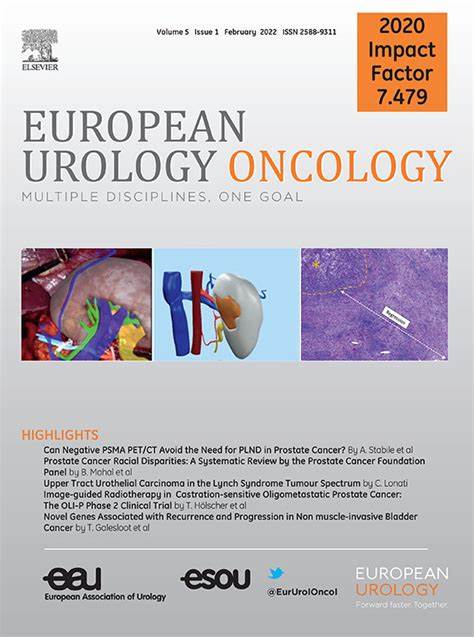Early Results from the CONFIRM Trial: Utility of Prostate-specific Membrane Antigen Positron Emission Tomography/Computed Tomography in Active Surveillance for Prostate Cancer
IF 9.3
1区 医学
Q1 ONCOLOGY
引用次数: 0
Abstract
Background and objective
There is growing evidence on the utility of prostate-specific membrane antigen (PSMA) positron emission tomography (PET)/computed tomography (CT) for detection of clinically significant prostate cancer (csPC), but there are limited data on its use in active surveillance (AS). The CONFIRM trial aims to determine the utility of PSMA PET/CT in detecting csPC before confirmatory biopsy during AS.
Methods
This is an initial analysis of a prospective, nonrandomised, crossover clinical trial (ANZCTR ID ACTRN12621001648819) that included men on AS for newly diagnosed low-grade prostate cancer (PC) with “high-risk” features. High risk was defined as grade group (GG) 1 disease with elevated prostate-specific antigen (PSA; >10 ng/ml, or PSA density >0.15 ng/ml/ml), high-volume GG 1, GG 1 with Prostate Imaging-Reporting and Data System 4 or 5 lesion on magnetic resonance imaging (MRI), or low-volume GG 2 PC. Patients underwent multiparametric MRI and [18F]-labelled radioligand PSMA PET/CT 3–6 mo after diagnosis, and confirmatory biopsy 6–9 mo after diagnosis.
Key findings and limitations
Between November 2021 and September 2023, 60 patients (median age 62.5 yr) were enrolled. PSMA-avid lesions were identified in 44 patients (73.3%), of whom 27 (61.4%) harboured csPC (GG ≥2). Of the PSMA-avid lesions, 20 (45.5%) were MRI-occult. At a subsequent multidisciplinary meeting, active treatment was recommended for 24 patients (40%), with PSMA PET/CT findings influencing 12 (20%) of the decisions. PSMA PET/CT provided reassurance regarding the decision to continue AS by excluding PSMA-avid lesions in 14 cases (38.9%) and multifocal disease in four (11.1%). Our findings are limited by the small sample size and short follow-up.
Conclusions and clinical implications
PSMA PET/CT appears to hold promise for improving risk stratification during AS by identifying csPC and MRI-occult lesions.
来自CONFIRM试验的早期结果:前列腺特异性膜抗原正电子发射断层扫描/计算机断层扫描在前列腺癌主动监测中的应用。
背景和目的:越来越多的证据表明前列腺特异性膜抗原(PSMA)正电子发射断层扫描(PET)/计算机断层扫描(CT)用于检测临床显著性前列腺癌(csPC),但其在主动监测(AS)中的应用数据有限。CONFIRM试验旨在确定PSMA PET/CT在AS确诊活检前检测csPC的效用。方法:这是一项前瞻性、非随机、交叉临床试验(ANZCTR ID ACTRN12621001648819)的初步分析,该试验纳入了新诊断为具有“高风险”特征的低级别前列腺癌(PC)的AS患者。高风险定义为前列腺特异性抗原(PSA)升高的GG组1级疾病;>10 ng/ml,或PSA密度>0.15 ng/ml),高容量GG 1,磁共振成像(MRI)上GG 1伴前列腺成像报告和数据系统4或5病变,或低体积GG 2 PC。患者在诊断后3-6个月进行多参数MRI和[18F]标记的放射配体PSMA PET/CT检查,并在诊断后6-9个月进行确诊性活检。主要发现和局限性:在2021年11月至2023年9月期间,纳入了60例患者(中位年龄62.5岁)。44例(73.3%)患者发现PSMA-avid病变,其中27例(61.4%)存在csPC (GG≥2)。psma强烈病变中,20例(45.5%)为mri隐匿性病变。在随后的多学科会议上,24名患者(40%)被推荐积极治疗,PSMA PET/CT结果影响了12名患者(20%)的决定。PSMA PET/CT通过排除14例(38.9%)PSMA强烈病变和4例(11.1%)多灶性疾病,为继续AS的决定提供了保证。我们的研究结果受到样本量小和随访时间短的限制。结论和临床意义:PSMA PET/CT似乎有望通过识别csPC和mri隐匿性病变来改善AS期间的风险分层。
本文章由计算机程序翻译,如有差异,请以英文原文为准。
求助全文
约1分钟内获得全文
求助全文
来源期刊

European urology oncology
Multiple-
CiteScore
15.50
自引率
2.40%
发文量
128
审稿时长
20 days
期刊介绍:
Journal Name: European Urology Oncology
Affiliation: Official Journal of the European Association of Urology
Focus:
First official publication of the EAU fully devoted to the study of genitourinary malignancies
Aims to deliver high-quality research
Content:
Includes original articles, opinion piece editorials, and invited reviews
Covers clinical, basic, and translational research
Publication Frequency: Six times a year in electronic format
 求助内容:
求助内容: 应助结果提醒方式:
应助结果提醒方式:


